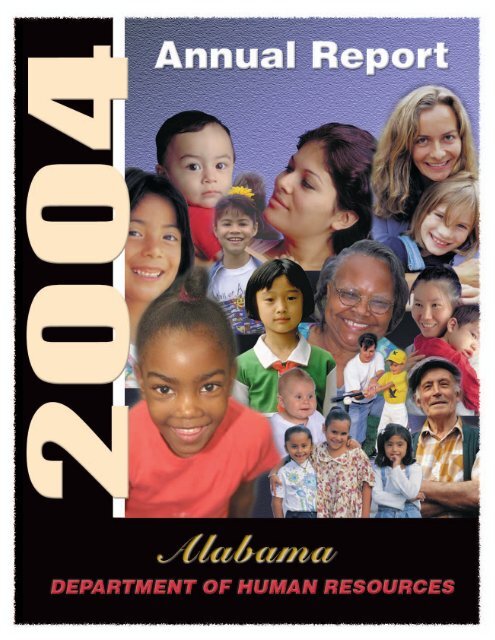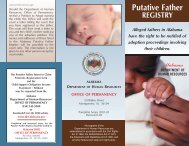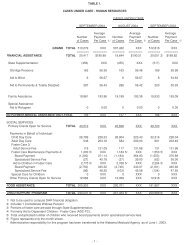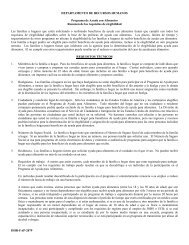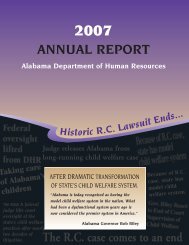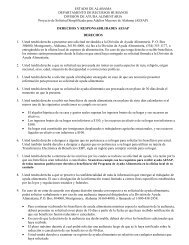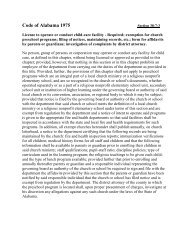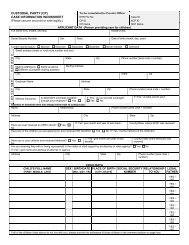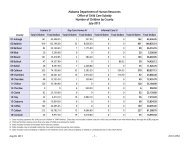04 ANNUAL REPORT 2 - Alabama Department of Human Resources
04 ANNUAL REPORT 2 - Alabama Department of Human Resources
04 ANNUAL REPORT 2 - Alabama Department of Human Resources
- No tags were found...
You also want an ePaper? Increase the reach of your titles
YUMPU automatically turns print PDFs into web optimized ePapers that Google loves.
RIVERR.RIVERR.★★★ALABAMAMISSISSIPPITOMBIG B EEGR E ATTENNESSEEBLACKALABAMATENNESS EEWARRIO RCA HABARIVERCOOSARIVERRIVERTA LL A POOSAPEACONECUH RIVERFLORIDAGulf <strong>of</strong> Mexi coGEORGIAS E A LBOB RILEYGovernor★★★State <strong>of</strong> <strong>Alabama</strong><strong>Department</strong> <strong>of</strong> <strong>Human</strong> <strong>Resources</strong>S. Gordon Persons Building50 Ripley StreetP.O. Box 3<strong>04</strong>000Montgomery, <strong>Alabama</strong> 36130-4000(334) 242-1310www.dhr.state.al.usPage B. Walley, Ph.D.CommissionerGovernor Bob Riley, ChairmanState Board <strong>of</strong> <strong>Human</strong> <strong>Resources</strong>Dear Governor Riley:These are very exciting times at the <strong>Department</strong> <strong>of</strong> <strong>Human</strong> <strong>Resources</strong>. The state’s child welfare system, oncefraught with deficiencies, is now hailed as a national standard for excellence. The transformation has garneredpraise from, and given hope to, other states that are grappling with the same obstacles that seemed insurmountablewhen <strong>Alabama</strong> began this journey more than a decade ago.In addition to implementing child welfare improvements, DHR continued to receive and investigate reports <strong>of</strong> suspectedabuse, neglect, and exploitation <strong>of</strong> disabled adults and the elderly. These vulnerable adults are <strong>of</strong>ten isolatedor have limited contact with others, which makes effective communication with our community partners extremelyimportant. An average <strong>of</strong> 29,986 children from low-income families received subsidized child care each month.The waiting list for subsidized child care climbed, in part, because a surplus in the state’s welfare block grant wasdepleted.A record $262 million in child support was collected in Fiscal Year 20<strong>04</strong> on behalf <strong>of</strong> dependent children. Thefederal government certified that the state’s child support computer system meets regulations, preventing theimposition <strong>of</strong> a penalty for noncompliance. The food stamp program bolstered the state’s economy while helpingmeet the nutritional needs <strong>of</strong> low-income families. More than a half billion dollars in food stamp benefits wasissued statewide in Fiscal Year 20<strong>04</strong>.From providing protective services-the agency’s number one legal responsibility-to administering programs to helpneedy families, the <strong>Department</strong> <strong>of</strong> <strong>Human</strong> <strong>Resources</strong> has a tradition <strong>of</strong> always seeking to answer the call. ThisAnnual Report documents the fact that this rich tradition continued during Fiscal Year 20<strong>04</strong>.Sincerely,Page B. Walley, Ph. D.CommissionerAn Affirmative Action/Equal Opportunity Employer
DIVERSE RESPONSIBILITIESThe department has some <strong>of</strong> the most diverse responsibilities <strong>of</strong> any public or private agency. Although commonlyreferred to as the “welfare department,” the agency’s number one legal responsibility is to preventabuse, neglect and exploitation.DHR4Some basic facts about the....<strong>Alabama</strong><strong>Department</strong> <strong>of</strong> <strong>Human</strong> <strong>Resources</strong>DHR’S MISSIONThe mission <strong>of</strong> the agency is to partner with communities to promote family stability and provide for thesafety and self-sufficiency <strong>of</strong> vulnerable Alabamians.MAJOR PROGRAMSThe <strong>Department</strong> <strong>of</strong> <strong>Human</strong> <strong>Resources</strong>’ major programs include: Family Services, Food Stamps, ChildSupport, Child Day Care, Adult Protective Services and Temporary Assistance for Needy Families (TANF).The agency does play a major role in assisting needy families through administration <strong>of</strong> the Food StampProgram and the welfare block grant (TANF). Support services are provided to help the families become selfsufficient.Most Alabamians are affected directly or indirectly by some DHR program, service or functioneach year.DHR BOARDSDHR operates under the State Board <strong>of</strong> <strong>Human</strong> <strong>Resources</strong>. The Governor, who serves as Board Chairman,appoints the board members who serve six-year terms. The State Board approves major administrativeactions, including the appointment <strong>of</strong> the Commissioner. The Board also approves the agency’s operatingbudget.The 67 county departments <strong>of</strong> <strong>Human</strong> <strong>Resources</strong> have boards that are appointed by county governments.City governments are involved in the appointment <strong>of</strong> County Board members in a few populous counties.DEPARTMENT EMPLOYEESThe agency has about 4,300 State Merit System employees, most <strong>of</strong> whom work in county DHR <strong>of</strong>fices.Social workers represent the largest category <strong>of</strong> DHR staff, although a variety <strong>of</strong> pr<strong>of</strong>essions are representedwithin the agency. Working with the Office <strong>of</strong> Management and Fiscal Analysis, DHR’s Personnel Office developedand implemented a staffing allocation process in FY 20<strong>04</strong> for county departments and for the agency’scentral <strong>of</strong>fice. The process ensures timely backfills <strong>of</strong> staffing positions while, at the same time, controllinglabor costs. This is crucial to DHR’s ability to provide services to the public promptly and efficiently.HISTORYThe <strong>Alabama</strong> <strong>Department</strong> <strong>of</strong> <strong>Human</strong> <strong>Resources</strong> was created in August 1935 to administer programs thatwere part <strong>of</strong> the Social Security Act. These programs were developed to help Americans suffering throughthe financial hardships <strong>of</strong> the Great Depression. The agency’s original name was the <strong>Department</strong> <strong>of</strong> PublicWelfare. In 1955, it was renamed the <strong>Department</strong> <strong>of</strong> Pensions and Security. The current name was adoptedin 1986. Some programs have changed over the years. However, the agency’s primary goal has always beento help people with problems.REVENUES AND EXPENDITURESIn Fiscal Year 20<strong>04</strong>, DHR’s revenues and expenditures totaled $1,121,107,131, including more than $500million in food stamp benefits. The federal government provided approximately 80% <strong>of</strong> the agency’s funds.Sources <strong>of</strong> state dollars included the General Fund, the Special Education Trust Fund, whiskey and beertaxes, and other earmarked taxes. Most <strong>of</strong> DHR’s federal funding comes through the U.S. <strong>Department</strong> <strong>of</strong>Agriculture and the U.S. <strong>Department</strong> <strong>of</strong> Health and <strong>Human</strong> Services (HHS).
Fiscal Year 20<strong>04</strong>FAMILY SERVICESFinal R.C. assertion delayed by IvanAfter years <strong>of</strong> making child welfare improvements thathave brought <strong>Alabama</strong> national acclaim, CullmanCounty’s R.C. assertion in September 20<strong>04</strong> was amuch-anticipated event. Cullman was to be the 67 th andfinal county to assert compliance with the very highstandards <strong>of</strong> the R.C. Consent Decree. The historicevent was postponed when Hurricane Ivan roaredthrough the state in mid-September. Cullman County’sassertion presentation was rescheduled for the month<strong>of</strong> October.The consent decree stemmed from a 1988 federal lawsuitfiled on behalf <strong>of</strong> a foster child identified only by hisinitials, “R.C.,” to protect his privacy. The settlement <strong>of</strong>the lawsuit in the early 1990s required the state torevamp its child welfare system. Under the agreement,<strong>Alabama</strong> retained control <strong>of</strong> the system, and a FederalCourt Monitor was appointed to oversee implementation<strong>of</strong> required improvements.Another significant development in child welfare in20<strong>04</strong> was the state’s completion <strong>of</strong> all the necessarysteps for its Program Improvement Plan (PIP). Allstates are required to develop a PIP following an on-sitereview by HHS, in order to make improvements towardcompliance with national standards and avoid federalpenalties. The PIP represents the federal government’sheightened emphasis on outcome-based evaluations <strong>of</strong>child welfare services.Hurricane Ivan delaysfinal R.C. assertionCAN reports increaseThe department investigated more than 19,000 childabuse and neglect reports in FY 20<strong>04</strong>, up fromapproximately 18,000 in FY 2003. In some instances,an investigation <strong>of</strong> an abuse or neglect report leads tothe child’s removal from the home and placement infoster care. In some areas <strong>of</strong> the state, the abuse <strong>of</strong>crystal methamphetamine resulted in a significantincrease in the number <strong>of</strong> children entering care.Between FY 2000 and FY 20<strong>04</strong>, statewide, almost 900children were placed in foster care because a parentor caregiver was abusing some type <strong>of</strong> drug.At the end <strong>of</strong> FY 20<strong>04</strong>, more than 6,000 children werein foster care in <strong>Alabama</strong>. The total includes approximately2,600 children who were in traditional fosterfamily homes and about 1,500 who were in grouphomes or residential care facilities. More than 1,300children were in therapeutic foster care, which providedfor children facing severe behavioral or emotionalproblems. The remainder were in their own homes orin related foster homes.20<strong>04</strong>Achievements, Challenges and ChangesAchievements, Challenges and Changes5
DHR’s response to potential foster andadoptive parents improved by participationin “Answering the Call” campaign.Adoption services accentuatedFor some children who come into care, reunificationwith their families is not the permanent plan. In caseswhere parental rights are terminated, the children areavailable for adoption. The department placed 315children with adoptive families in FY 20<strong>04</strong>. The statereceived an incentive award from HHS for improvedperformance in adoption placements. At the end <strong>of</strong>the fiscal year, 284 children in DHR’s permanent custodyhad no identified adoption resource.The department’s Adoption Policy Manual was revisedand released, and training was provided to countystaff in August 20<strong>04</strong>. AdoptUSKids, which featuresphotos <strong>of</strong> children awaiting permanent homes, startedthe “Answering the Call” marketing campaign. As part<strong>of</strong> the effort, AdoptUSKids financed a RecruitmentResponse Team (RRT) in each state. In <strong>Alabama</strong>, theteam members included DHR and the Children’s AidSociety. Participation in the “Answering the Call” campaignimproved DHR’s responsiveness to potentialfoster and adoptive parents.DHR gets two new deputiesTwo veteran employees were appointed deputy commissionersduring FY 20<strong>04</strong>. Carolyn B. Lapsley was appointed DeputyCommissioner for Children and Family Services. Ms. Lapsleybrought twenty-six years <strong>of</strong> experience to the position,including twenty-three years in child welfare services. Forthree years, she was director <strong>of</strong> DHR’s Child SupportEnforcement Division. Prior to being appointed DeputyCommissioner for Children and Family Services, Ms. Lapsleyserved as R.C. Coordinator during the overhaul <strong>of</strong> the state’schild welfare system. She became the agency’s first African-American deputy commissioner.Belyn Richardson was appointed Deputy Commissioner forQuality Assurance and Information Services, marking hersecond stint with the agency. Richardson had retired fromDHR before she was named Assistant Director <strong>of</strong> the state<strong>Department</strong> <strong>of</strong> Children’s Affairs. She served in that postuntil she rejoined DHR. The appointments <strong>of</strong> Lapsley andRichardson gave the department a total <strong>of</strong> five deputy commissioners.The other deputy commissioners are P. L. Corley(Fiscal and Administrative Services), Terrie Reid (Family<strong>Resources</strong>), and James Slaughter (Field Administration).Foster Parent Bill <strong>of</strong> Rights becomes lawIn April 20<strong>04</strong>, Governor Bob Riley signed the FosterParent Bill <strong>of</strong> Rights into law. Commissioner PageWalley supported the bill, which passed with bipartisansupport among state lawmakers. Senator SundraEscott (D-Birmingham) and Representative MacGipson (R-Prattville) co-sponsored the legislation. Thelaw gave foster parents specific rights, includingaccess to certain information, training and services.CHILD SUPPORT ENFORCEMENTA record $262 million in child support was collectedstatewide during FY 20<strong>04</strong>, eclipsing the $256 millioncollected in the previous year. Support collected innon-welfare cases makes it less likely that the familywill have to go on government assistance. In welfarecases, child support collections help recoup the cost<strong>of</strong> providing government assistance to the noncustodialparent’s dependent children. The child support programserved more than 185,000 dependent children inFY 20<strong>04</strong>.Increased use <strong>of</strong> electronic communicationIn November 2003, child support payment informationbecame available online to both custodial and noncustodialparents. It was anticipated that the availability<strong>of</strong> the information online would reduce the volume <strong>of</strong>calls to the agency’s toll free hotline.During the year, DHR began handling consumer creditcomplaints electronically rather than by mail. Thecomplaints usually come from noncustodial parentswho discover that delinquent child support paymentshave an adverse impact on their credit rating.Transmitting information to credit bureaus electronicallywas expected to simplify the process for resolvingthe complaints. It was also expected to give countystaff more time for tasks related to collecting supporton behalf <strong>of</strong> dependent children.MILLIONS OFDOLLARS30025020015010050YEARCHILD SUPPORT COLLECTION$256,000,000.00 $262,000,000.00$240,000,000.00 ●●$229,000,000.00 ●$219,000,000.00 ●●2000 2001 2002 2003 20<strong>04</strong>6
FOOD ASSISTANCEStill a nutritional safety netFollowing a national trend, there was an increase inthe average number <strong>of</strong> <strong>Alabama</strong> households receivingfood stamps each month. An average <strong>of</strong> 197,237 familiesreceived food stamps monthly, compared to amonthly average <strong>of</strong> 185,028 in the previous year. Thisrepresented a 6.5% increase in participation. Familiesreceived more than $506 million in food stamp benefits,compared to the $466 million in benefits providedthe year before. Households received a monthly average<strong>of</strong> $216.58 in benefits in FY 20<strong>04</strong>, up from themonthly average <strong>of</strong> $209.93 food stamp familiesreceived the previous year.Semiannual reporting simplifiesprogram administrationIn August 20<strong>04</strong>, <strong>Alabama</strong> implemented the semiannualreporting option, which permits states to provide ahousehold with six months <strong>of</strong> continuous food stampeligibility at a constant benefit level. If during this sixmonthperiod the household’s income exceeds thegross income limit for the program, the change mustbe reported to the food stamp agency.MILLIONSOFDOLLARS60050<strong>04</strong>00300200100FOOD STAMPS ISSUED$506,000,000.00$467,000,000.00 ●●$417,000,000.00$364,000,000.00 ●$344,000,000.00 ●●2000 2001 2002 2003 20<strong>04</strong>YEARSemiannual reporting, which has been available sinceearly 2001, was one <strong>of</strong> several new options the U.S.<strong>Department</strong> <strong>of</strong> Agriculture (USDA) has provided tostates in recent years. The options are designed toimprove access and participation, and to simplifyadministration <strong>of</strong> the program.Monster storm presents stern test;DHR deliversAs Hurricane Ivan churned menacingly toward<strong>Alabama</strong>’s Gulf Coast in mid-September 20<strong>04</strong>, DHRMrs. Jennie Helderman presents award to Joe Williams <strong>of</strong>Conecuh County DHR on behalf <strong>of</strong> the DHR State Board, inrecognition <strong>of</strong> the county’s outstanding work during HurricaneIvan. Other counties were also recognized by the State Board.Commissioner Page Walley contacted USDA <strong>of</strong>ficials tomake arrangements to address the potential foodneeds <strong>of</strong> storm victims. Working with its public andprivate sector community partners, DHR began gatheringthe federally required storm information. WithUSDA approval, more than 59,000 families in the 24hardest hit counties received a total <strong>of</strong> $13 million infood stamp benefits. Families who were already participatingin the program received this assistance,which was provided to replace food lost due to stormrelatedpower outages.More than 59,000 families in the 24hardest hit counties received a total <strong>of</strong>$13 million in food stamp benefits20<strong>04</strong>The approval included: Autauga, Elmore, Dallas, Hale,Wilcox, Marengo, Montgomery, Lowndes, Choctaw,Sumter, Perry, Greene, Baldwin, Butler, C<strong>of</strong>fee,Conecuh, Covington, Crenshaw, Escambia, Geneva,Mobile, Monroe, Washington and Clarke counties.For seven <strong>of</strong> the counties (Baldwin, Clarke, Conecuh,Covington, Escambia, Monroe and Mobile), the USDAauthorized supplemental food stamp benefits to beprovided to recipients in October. Food stamp benefitswere posted to the Electronic Benefit Transfer (EBT)7
accounts <strong>of</strong> eligible storm victims in accordance withfederal regulations.As the fiscal year drew to a close, DHR was seekingfederal authorization for a disaster food stamp program,which would help families who normally would notqualify. This would help families in need <strong>of</strong> food assistancebecause <strong>of</strong> hurricane-related losses <strong>of</strong> incomeand other financial resources.The DHR State Board presented awards to county departments<strong>of</strong> <strong>Human</strong> <strong>Resources</strong> and to individual state and countyemployees, in recognition <strong>of</strong> exemplary performance duringHurricane Ivan. Recipients included:Baldwin County: Wanda Peavy, Administrative Assistant II; and theBaldwin County DHR.Clarke County: Mary Andrews, Financial Support Supervisor; andthe Clarke County DHR staff.Conecuh County DHR staff.Covington County: Cathy Leverington, Director; and theCovington County DHR.Escambia County: Melinda Robinson, Luella Jackson, Diane Museand the Escambia County DHR.Mobile County: Donna Martin and the Mobile County DHR.Monroe County: Janie Stallworth, Administrative Assistant I; andthe Monroe County DHR.Charles Johnson - Program Administrator, Office <strong>of</strong> EmergencyWelfare Services and Employee Safety.Joyce O’Neal and her staff - The DHR State Board also recognizedFood Assistance Division Director Joyce O’Neal and her stafffor providing expertise and leadership in planning and coordinatingrelief efforts with the USDA, and with state and local governments.FAMILY ASSISTANCEThe number <strong>of</strong> families receiving TemporaryAssistance for Needy Families (TANF) did not increasesignificantly in FY 20<strong>04</strong>. A monthly average <strong>of</strong> 19,266families received welfare payments, compared to amonthly average <strong>of</strong> 19,069 the previous year. Evenwith the slight increase over the past few years, thepublic assistance rolls are still much lower than theywere before passage <strong>of</strong> the federal welfare reform law<strong>of</strong> 1996. The Personal Responsibility and WorkOpportunity Reconciliation Act (Public Law 1<strong>04</strong>-193)made sweeping changes in the nation’s welfare system.The historic legislation imposed a time limit forreceiving welfare benefits, and replaced AFDC (Aid to8The number <strong>of</strong> welfare families in<strong>Alabama</strong> has decreased significantlyin the past eight years.State receives $5.56 million bonusfrom federal <strong>Department</strong> <strong>of</strong> Healthand <strong>Human</strong> Services foroutstanding performance.Families with Dependent Children) with the TANF(Temporary Assistance for Needy Families) BlockGrant. States were given more flexibility in administeringtheir public assistance programs, and were ableto fund job training and support services as lessmoney was required for the declining caseload.With administrative flexibility and the support <strong>of</strong> businessesand other community partners, DHR has beensuccessful in moving recipients from the welfare rollsto jobs. In August 1996 when the welfare reform lawwas signed, almost 41,000 families were receivingmonthly welfare payments in <strong>Alabama</strong>. Eight yearslater, in August 20<strong>04</strong>, there were approximately19,000 welfare families in the state.A successful partnershipThe state received a $5.56 million bonus from the federal<strong>Department</strong> <strong>of</strong> Health and <strong>Human</strong> Services (HHS)for outstanding performance in moving recipientsfrom welfare to work and self-sufficiency. The awardwas based, in part, on <strong>Alabama</strong>’s high ranking in the“Success in the Workforce” category in which currentand former recipients in the state had the eighthbiggest increase in earnings from one year to the next.The state was ranked number one in having thebiggest increase in food stamp participation amongeligible low-income working families with children.The agency worked with faith-based organizations andother agencies to plan and conduct a statewide fatherhoodconference that was held in June 20<strong>04</strong>. Thedepartment continued the <strong>Alabama</strong> FatherhoodInitiative, which helps fathers obtain better jobs andincrease their earnings. With higher wages, they arebetter able to support their children.For several years, a steady decline in the number <strong>of</strong><strong>Alabama</strong> welfare families, coupled with some flexibilityin federal law, meant that TANF money could beused to meet other needs. Federal law permits statesto transfer some TANF funds to the Social Services
Block Grant (Title XX), and to child care assistance.The transfer to the Social Services Block Grant helpedfund child welfare services associated with the R.C.Consent Decree. The child care transfer helps to providesubsidized child care to low-income working families.An increase in the number <strong>of</strong> TANF families anda December 2002 increase in welfare benefits reducedthe amount <strong>of</strong> money available for subsidized childcare.ADULT PROTECTIVE SERVICESThe <strong>Department</strong> <strong>of</strong> <strong>Human</strong> <strong>Resources</strong> is responsiblefor protecting disabled adults and the elderly fromabuse, neglect and exploitation. This responsibility is<strong>of</strong>ten overshadowed by focus on the agency’s effortsto prevent and remedy the abuse and neglect <strong>of</strong> children.Unlike children, whose interaction with others providesan opportunity for possible abuse or neglect tobe detected, disabled adults and the elderly are <strong>of</strong>tenisolated. It is this isolation that makes them primetargets for abuse, neglect and exploitation, and it isnot unusual for the perpetrator to be a relative.In FY 20<strong>04</strong>, statewide, DHR investigated 4,739 reports<strong>of</strong> adult abuse and neglect, up slightly from the 4,691reports investigated in FY 2003. The agency reliesupon its public and private sector community partnersto protect vulnerable adults. In FY 20<strong>04</strong>, DHR workedwith the state Attorney General’s Family ProtectionUnit, the state <strong>Department</strong> <strong>of</strong> Senior Services and theAmerican Association <strong>of</strong> Retired Persons (AARP) inconducting interdisciplinary seminars on elder abuse.Seven regional meetings were held during the year.The agency allocated available funding to countydepartments <strong>of</strong> <strong>Human</strong> <strong>Resources</strong> for homemakerservices and day care for adults. Minimum staffinglevels were established for Adult Protective Services(APS), assuring that core resources were reassignedto ensure that each county APS program has a fieldconsultant, and on-site training was provided forcounty APS workers. The department initiated ananalysis <strong>of</strong> services that DHR and the state<strong>Department</strong> <strong>of</strong> Senior Services provide to the elderly.CHILD DAY CAREA monthly average <strong>of</strong> 29,986 children received subsidizedcare through the <strong>Department</strong> <strong>of</strong> <strong>Human</strong><strong>Resources</strong> in Fiscal Year 20<strong>04</strong>. The year before, themonthly average was 38,351 children.A monthly average <strong>of</strong> 29,986 childrenreceived subsidized care throughDHR in Fiscal Year 20<strong>04</strong>.Total spending for day care slots was approximately$85.6 million in FY 20<strong>04</strong>, compared to $108 millionduring the previous year. In recent years, fewer familieson welfare meant more money was available fortransfer from the TANF Block Grant. Growing welfarerolls meant less money could be transferred to childcare. The ongoing funding <strong>of</strong> a December 2002 TANFbenefit increase was another factor in the decreasedchild care spending.The department saved tax dollars when it reduced thenumber <strong>of</strong> regions served by child care management(CMAs) agencies from 12 to 9, in FY 20<strong>04</strong>. The CMAshandle child care subsidy eligibility and case management,under a contract with DHR. The administrativesavings were used to help provide subsidized childcare for low-income families.In September 20<strong>04</strong>, DHR reduced the child/staffratios for licensed day care centers. The ratioreductions were implemented to improve child safety.The child/staff ratios and other changes were recommendedby a committee that included child careadvocates and day care providers.PROGRAM INTEGRITYThe <strong>Department</strong> <strong>of</strong> <strong>Human</strong> <strong>Resources</strong> is firmly committedto being a good steward <strong>of</strong> the taxpayers’ dollarsthat are entrusted to the agency each year. Thisincludes recouping benefit overpayments, whetherthey resulted from intentional fraud, a misunderstanding<strong>of</strong> program regulations or from an administrativeerror. The agency recovered a total <strong>of</strong> $2.2 million infood stamp and TANF (Temporary Assistance forNeedy Families) benefit overpayments in Fiscal Year20<strong>04</strong>. Approximately $800,000 <strong>of</strong> the total was recoveredthrough wage garnishments and by interceptingfederal and state income tax refunds.20<strong>04</strong>An interagency agreement between DHR and the stateAttorney General’s Welfare Fraud Unit produced 96criminal convictions in FY 20<strong>04</strong>. Under the agreement,9
fraud cases involving $1,000 or more are referred tothe Attorney General’s Office. Fraud cases involvingless than $1,000 are handled administratively by DHR.In cases where the overpayment is less than $1,000and the food stamp recipient disagrees with the classification<strong>of</strong> the debt as fraud, an AdministrativeDisqualification Hearing (ADH) is held. The debt isthen classified as either fraud or non-fraud. During theyear, there were 236 ADH convictions and 387 waiverssigned in which clients agreed to the fraud classification<strong>of</strong> the debt.As part <strong>of</strong> DHR’s commitment to fiscal prudence andaccountability, the agency’s Fiscal Integrity Divisionprovided training and technical assistance to countydepartments <strong>of</strong> <strong>Human</strong> <strong>Resources</strong>. The trainingemphasized the proper procedures for accessing andusing funds available to the counties.PACT Unit createdThe Public Accountability and Commitment Team(PACT) was established in March 20<strong>04</strong>, and becameoperational in June 20<strong>04</strong>. The team consists <strong>of</strong> several<strong>of</strong> DHR’s veteran program experts. The PACT unit wasestablished by consolidating the agency’s consumercomplaint and response resources. A toll free numberwas set up to receive complaints and provide informationto the public.The team includes a Complaint Resolution Unit and anInvestigative Unit. The concept envisioned a centralrepository database for all departmental inquiries,complaints and investigative requests from public andlegislative sources. The PACT staff also handles assistancefunctions assigned by the Commissioner, andprovides on-call services to field <strong>of</strong>fices.In the four months that PACT was fully operational inFY 20<strong>04</strong>, 60% <strong>of</strong> the inquiries came via telephone,29% by email and 11% by letter. Forty-four percent <strong>of</strong>the inquiries concerned either child support or foodstamps. The remainder involved alleged abuse orneglect, child custody, family assistance and relatedissues.The unit played a key role during DHR’s emergencyresponse to Hurricane Ivan, assisting with the gatheringand dissemination <strong>of</strong> information to the public.The team responded to approximately 8,000 stormrelatedinquiries.10Public Accountability & Commitment TeamInquiry Source29%11%60%TelephoneE-mailLetterCenter for Information ServicesThe Center for Information Services (CIS), once again,played an integral role in the agency’s delivery <strong>of</strong>services to the public and compliance with federalguidelines and regulations. The cooperative efforts <strong>of</strong>state and county staff, CIS, DHR’s community partnersand others produced many successful outcomes suchas:❒ federal certification <strong>of</strong> the state’s child supportcomputer system;❒ the completion <strong>of</strong> an online system that permitscitizens to track their child support payments onthe Internet;❒ providing technical support that facilitated themoney-saving consolidation <strong>of</strong> child care managementagencies;❒ making modifications to support the federally20<strong>04</strong>mandated data tracking necessary for theProgram Improvement Plan for child welfare;❒ making system modifications to maximize theclaiming <strong>of</strong> federal reimbursements for servicesprovided to child welfare clients;❒ and processing huge amounts <strong>of</strong> informationneeded to provide food stamp benefits to victims<strong>of</strong> Hurricane Ivan.
REVENUES AND EXPENDITURES FOR 20<strong>04</strong>EXPENDITURESSalaries $149,971,891 Transportation EquipmentEmployee Benefits 45,<strong>04</strong>6,779 Operating Costs 25,836In-state Travel 6,034,650 Grants & Benefits 846,706,861Out-<strong>of</strong>-State Travel 184,991 Transportation EquipmentRepairs & Maintenance 595,547 Purchases 0Rents & Leases 14,814,291 Other Equipment Purchases 365,101Utilities & Communications 10,193,073 Non-ExpenditurePr<strong>of</strong>essional Services 41,109,595 Disbursements 58,514Supplies, Materials &Operating Expenses 6,000,002 $1,121,107,131SOURCES OF FUNDSFederal and Local FundsFederal share <strong>of</strong>Child Support Collections $6,693,762Title IV-A Federal Funds (102,520)TANF Block Grant 75,998,482Title IV-B Federal Funds 15,535,821Title IV-D Federal Funds 37,757,330Title IV-E Federal Funds 26,037,988Title XIX Federal Funds 82,923,019Title XX Federal Funds 36,940,535Child Day CareDiscretionary Fund 59,452,510Child Day Care-Mandatory 16,441,707Child Day Care-Matching 17,093,907Federal Refugee Assistance 0Federal USDA Funds 533,939,183Federal Child Abuse Grant 479,621Other Federal Funds 332,166Local Contract Funds 332,158Child Support Interest and Fees 316,266Other Local Funds 0Adult Services Trust Fund 0State FundsGeneral Fund $78,594,324Education Trust Fund 6,621,739Whiskey Tax 26,283,847ABC Pr<strong>of</strong>its 845,715Beer Tax 10,436,609Pension Residue 20,773,500Sales Tax 1,322,000Sales Tax-Foster Care 500,000Sales Tax-Food Stamp 24,706,726Franchise Tax 15,714Tobacco Tax 3,484,406Contractors’ Gross Receipts 4,195,020State Share <strong>of</strong> ChildSupport Collections 4,306,238Food Stamp Overissuance 379,731Other State Funds 993,242MNC Agencies 3,369,619MNC Agencies-OUR KIDS 1,996,200Children First Fund 14,540,694Foster Care Trust Fund 21,888Net Unencumbered Balance 7,547,984Total Funds Available $1,121,107,13111
CONTENTSPAGETable 1. Cases Under Care - <strong>Human</strong> <strong>Resources</strong> ........................................................................13Table 2.Number <strong>of</strong> Cases Receiving Financial Assistance andAverage Amount <strong>of</strong> Payments To These Cases ............................................................14Table 3. Aid to Refugees ............................................................................................................15Table 4.Table 5.Table 6.Number <strong>of</strong> Individuals Certified as CurrentlyEligible for Medical Assistance Under Title XIX(by the <strong>Department</strong> <strong>of</strong> <strong>Human</strong> <strong>Resources</strong>) toThe <strong>Alabama</strong> Medicaid Agency ....................................................................................15Number <strong>of</strong> Cases Receiving Financial Assistance andAverage Amount <strong>of</strong> Assistance Per Case (By County) ..................................................16Cases Approved as Categorically Related andEligible for Title XIX But Receiving No Money Payment................................................17Table 7. Reasons for Denial - Family Assistance Cases ............................................................18Table 8. Reasons for Opening - Family Assistance Cases ..........................................................18Table 9. Reasons for Closing - Family Assistance Cases ..........................................................19Table 10.Table 11.Table 12.Table 13.Social Services in County <strong>Department</strong>s........................................................................20Child Day Care..............................................................................................................21Adult Day Care..............................................................................................................22Adult Foster Care..........................................................................................................23Table 14. Foster Care for Children ..............................................................................................24Table 15.Table 16.Table 17.Table 18.Table 19.Table 20.Adoption Petitions Referred by Probate Courts............................................................25Children Under Care <strong>of</strong> Public and Private Facilities....................................................26Cases <strong>of</strong> Abuse, Neglect, Dependency and Special Proceedings ReportedDisposed <strong>of</strong> by <strong>Alabama</strong> Juvenile Courts ....................................................................27Food Stamp Program - Monthly AverageParticipation (By County)..............................................................................................28Child Support Cases and Collections............................................................................29Job Opportunities and Basic Skills (JOBS) Training Program......................................3012
DHR State Office DirectoryAll <strong>of</strong>fices listed below are located in Montgomery.The area code is 334242-1310 DHR Information353-1115 Fax number for informationjbradford@state.al.us Email address for informationwww.dhr.state.al.usDHR Web site242-1160 Commissioner’s Office (Dr. Page Walley)242-1160 Executive Assistant/Ethics Officer (Nancy Jinright)242-8395 Deputy Commissioner for Fiscal and AdministrativeDHRServices (P. L. Corley)242-9378 Deputy Commissioner for Family <strong>Resources</strong> (Terrie Reid)353-1170 Deputy Commissioner for Field Administration (James Slaughter)353-1170 Deputy Commissioner for Children and Family Services (CarolynB. Lapsley)242-1350 Adult Protective Services (Doris Ball)242-1325 Administrative Hearings (William Prendergast)242-3244 Center for Information Services (Duey Kerper)242-9300 Child Support Enforcement (Diana McCampbell)242-1425 Child Day Care (Debbie Thomas)242-1550 Civil Rights/Equal Employment (Larry Sims)242-1723 Electronic Benefits Transfer (Johnnie Cox)242-9275 Emergency Welfare Services and Employee Safety (Charles Johnson)242-9500 Family Services (Margaret Bonham)242-1950 Family Assistance (Joel Sanders)242-9425 Finance (Jim Connell)242-1700 Food Stamps (Joyce O’Neal)240-6800 General Services (Lester Thomas)242-1850 Public Information (John Bradford)242-9330 Legal (Sharon Ficquette)242-3327 Management and Fiscal Analysis (Mike Salter)242-1780 Personnel (Thomas King)242-1900 Fiscal Integrity (Charles Cook)242-1450 Quality Control (Blaine Smith)242-1650 Resource Management and Utilization Review (Susan Ward)31
WDirectory <strong>of</strong> DHR County <strong>Department</strong>sith some exceptions, the programs and services <strong>of</strong> the <strong>Alabama</strong> <strong>Department</strong> <strong>of</strong> <strong>Human</strong> <strong>Resources</strong> areprovided by or through the agency’s 67 county departments <strong>of</strong> <strong>Human</strong> <strong>Resources</strong>. All DHR countydepartments have boards appointed by local governments. These County Boards <strong>of</strong> <strong>Human</strong> <strong>Resources</strong> arethe hiring authority for the DHR County Director. The County Director is accountable to the County Board.AUTAUGA CALHOUN CLEBURNEDirector: Katey Russell Director: John James Director: Marsha Busby203 North Court Street 801 Noble Street 732 Oxford StreetPrattville, AL 36067 Anniston, AL 36202 Heflin, AL 36264telephone: (334) 358-5000 telephone: (256) 231-7500 telephone: (256) 463-1700BALDWIN CHAMBERS COFFEEDirector: Rene’ M. Massey Director: Julia Ann Hyde Director: Joyce Stanford1705 Highway 31 South 6287 Fairfax Bypass 3881 Salem RoadBay Minette, AL 36507 Valley, AL 36854 Enterprise, AL 36331telephone: (251) 580-2800 telephone: (334) 756-2282 telephone: (334) 348-2000BARBOUR CHEROKEE COLBERTDirector: Mary Russ Director: Cathy Miller Director: Louise TaylorClayton Industrial Park 202 Hospital Avenue 3105 George Wallace Blvd.276 Highway 239 South Centre, AL 35960 Muscle Shoals, AL 35661Clayton, AL 36016 telephone: (256) 927-1440 telephone: (256) 314-4900telephone: (334) 775-2000BIBB CHILTON CONECUHDirector: Wanda Lewis Director: Winiferd Adams Director: Lou Ida Boykin84 Library Street 500 Airport Road Highway 83Centreville, AL 35<strong>04</strong>2 Clanton, AL 35<strong>04</strong>6 Evergreen, AL 36401telephone: (205) 926-2900 telephone: (205) 280-2000 telephone: (251) 578-3900BLOUNT CHOCTAW COOSADirector: Marcia Parker Director: Voncile Jackson Director: Brenda Strength415 Fifth Avenue East 1003 Mulberry Avenue 300 South Jackson StreetOneonta, AL 35121 Butler, AL 369<strong>04</strong> Rockford, AL 35136telephone: (205) 274-5200 telephone: (205) 459-9701 telephone: (256) 377-2000BULLOCK CLARK COVINGTONDirector: Janet Rainer Director: Peggie Tucker Director: Cathy Leverington201 North Powell Street Highway 84 East 1515 Martin Luther King Exp.Union Springs, AL 36089 Grove Hill, AL 36451 Andalusia, AL 36420telephone: (334) 738-2740 telephone: (251) 275-7001 telephone: (334) 427-7900BUTLER CLAY CRENSHAWDirector: Frieda Stevens Director: Kay Robertson Interim Director: Frieda Stevens109 Caldwell Street 86930 Highway 9 25 Hospital DriveGreenville, AL 36037 Lineville, AL 36266 Luverne, AL 36<strong>04</strong>9telephone: (334) 382-4400 telephone: (256) 396-6800 telephone: (334) 335-700032
CULLMAN GENEVA LAWRENCEInterim Director: Larry Ayers Director: Jennifer DeMarcus Director: Larry Terry210 Fourth Street, SW 617 South Commerce Street 13280 <strong>Alabama</strong> Hwy 157Cullman, AL 35056 Geneva, AL 36340 Moulton, AL 35650telephone: (256) 737-5300 telephone: (334) 684-5800 telephone: (256) 905-3100DALE GREENE LEEDirector: Sylvia Dodgen Director: Pearson McGhee Director: Jan BurkeP.O. Box 447 Highway 43 South 2015 Gateway Drive513 Carroll Avenue Eutaw, AL 35462 Opelika, AL 36803Ozark, AL 36361 telephone: (205) 372-5000 telephone: (334) 737-1100telephone: (334) 445-4900DALLAS HALE LIMESTONEDirector: James Ware Director: Sharon Jay Director: Caroline Page200 Samuel O. Moseley Drive 906 Wheelan Street 1007 West Market StreetSelma, AL 36702 Greensboro, AL 36744 Athens, AL 35612telephone: (334) 874-1400 telephone: (334) 624-5820 telephone: (256) 216-6380DEKALB HENRY LOWNDESDirector: Jennice Floyd Director: Joy Crawford Director: Faye Nelson2301 Briarwood Avenue, S. 507 Kirkland Street 382 Commerce Street SouthFort Payne, AL 35968 Abbeville, AL 36310 Hayneville, AL 36<strong>04</strong>0telephone: (256) 884-2700 telephone: (334) 585-4100 telephone: (334) 548-3800ELMORE HOUSTON MACONDirector: Cecelia Ball Director: Mary Paulk Director: Febreu Holston73932 Tallassee Highway 1605 Ross Clark Circle, SE 4<strong>04</strong> North Main StreetWetumpka, AL 36092 Dothan, AL 36301 Tuskegee, AL 36083telephone: (334) 514-3200 telephone: (334) 677-<strong>04</strong>00 telephone: (334) 725-2100ESCAMBIA JACKSON MADISONDirector: Lynn Barnes Director: Sheenia B. Little Director: Drenda King326 Evergreen Avenue 205 Liberty Lane 2206 Oakwood Avenue, NWBrewton, AL 36427 Scottsboro, AL 35769 Huntsville, AL 35810telephone: (251) 809-2000 telephone: (256) 574-0300 telephone: (256) 535-4500ETOWAH JEFFERSON MARENGODirector: Henry Small Director: Caro Shanahan Director: Jack Marler, III741 Forrest Avenue 1321 5th Ave. South 701 South Shiloh StreetGadsden, AL 35902 Birmingham, AL 35202-1926 Linden, AL 36748telephone: (256) 549-4100 telephone: (205) 918-5100 telephone: (334) 295-2000FAYETTE LAMAR MARIONDirector: Jason R. Cowart Supervisor-in-Charge: James E. Morton Director: Bonnie Riley410 16th Street, NE 250 Springfield Road 1435 Military Street NorthFayette, AL 35555 Vernon, AL 35592 Hamilton, AL 35570telephone: (205) 932-1665 telephone: (205) 695-5000 telephone: (205) 921-6000FRANKLIN LAUDERDALE MARSHALLDirector: Jerry Groce Director: Cindy Bratcher Director: Wayne Sellers737 Highway 48 424 Veterans Drive 1925 Gunter AvenueRussellville, AL 35653 Florence, AL 35631 Guntersville, AL 35976telephone: (256) 331-5900 20<strong>04</strong>33telephone: (256) 765-4000 telephone: (256) 582-7100
MOBILE RANDOLPH TUSCALOOSADirector: Rose Johnson Director: Sharon Mintz Director: Judy Young850 St. Anthony Street 865 Hill Crest Avenue 3716 12th Avenue EastMobile, AL 36633 Wedowee, AL 36278 Tuscaloosa, AL 35405telephone: (251) 415-3500 telephone: (256) 357-3000 telephone: (205) 554-1100MONROE RUSSELL WALKERDirector: Allen Powell Director: Wanda Martin Director: Randy Redmill25 Legion Drive 1003 25th Avenue 1901 Highway 78 EastMonroeville, AL 36460 Phenix City, AL 36868 Jasper, AL 35502telephone: (251) 743-5900 telephone: (334) 214-5780 telephone: (205) 387-5400MONTGOMERY ST. CLAIR WASHINGTONDirector: Terry Benton Interim Director: Mary Ashcraft Director: Brenda T. Taylor3030 Mobile Highway 3105 15th Avenue North 712 St. Stephens AvenueMontgomery, AL 36108 Pell City, AL 35125 Chatom, AL 36518telephone: (334) 293-3100 telephone: (205) 812-2100 telephone: (251) 847-6100MORGAN SHELBY WILCOXInterim Director: Caroline Page Director: Chris Monceret Director: John Lisenbe507 14th Street, SE 987 Highway 70 112 Water StreetDecatur, AL 35602 Columbiana, AL 35051 Camden, AL 36726telephone: (256) 340-5840 telephone: (205) 669-3000 telephone: (334) 682-1200PERRY SUMTER WINSTONDirector: Alvin Reed Director: Nancy Wilson Director: Dale Hendrix, Jr.1609 Highway 5 South 108 West Main Street 991 Highway 33 NorthMarion, AL 36756 Livingston, AL 35470 Double Springs, AL 35553telephone: (334) 683-5500 telephone: (205) 652-5000 telephone: (205) 489-1500PICKENSTALLADEGADirector: Gail ShelferDirector: Mary AshcraftCourthouse Annex P. O. Drawer 539Carrollton, AL 35447 Talladega, AL 35161telephone: (205) 367-1500 telephone: (256) 761-6600PIKETALLAPOOSADirector: Florence MitchellDirector: Marsha Hanks717 South Three Notch Street 353 North Broadnax StreetTroy, AL 36081 Dadeville, AL 36853telephone: (334) 807-6120 telephone: (256) 825-27553420<strong>04</strong>
NOTES20<strong>04</strong>35
36NOTES
ALABAMA<strong>Department</strong> <strong>of</strong> <strong>Human</strong> <strong>Resources</strong>50 Ripley StreetMontgomery, <strong>Alabama</strong> 36130


